Related Research Articles

A deacon is a member of the diaconate, an office in Christian churches that is generally associated with service of some kind, but which varies among theological and denominational traditions. Major Christian churches, such as the Catholic Church, the Oriental Orthodox Churches, the Eastern Orthodox Church, the Scandinavian Lutheran Churches, the Methodist Churches, the Anglican Communion, and the Free Church of England, view the diaconate as an order of ministry.
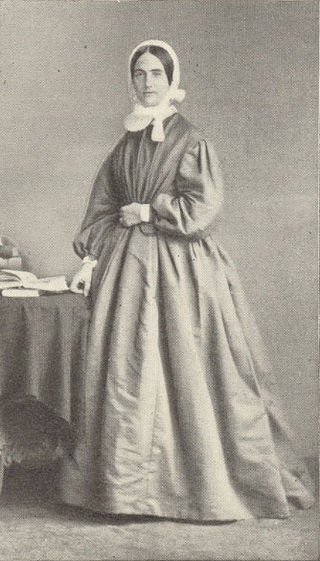
The ministry of a deaconess is a usually non-ordained ministry for women in some Protestant, Oriental Orthodox, and Eastern Orthodox churches to provide pastoral care, especially for other women, and which may carry a limited liturgical role. The word comes from the Greek diakonos (διάκονος), for "deacon", which means a servant or helper and occurs frequently in the Christian New Testament of the Bible. Deaconesses trace their roots from the time of Jesus Christ through to the 13th century in the West. They existed from the early through the middle Byzantine periods in Constantinople and Jerusalem; the office may also have existed in Western European churches. There is evidence to support the idea that the diaconate including women in the Byzantine Church of the early and middle Byzantine periods was recognized as one of the major non-ordained orders of clergy.

Theodor Fliedner was a German Lutheran minister and founder of Lutheran deaconess training. In 1836, he founded Kaiserswerther Diakonie, a hospital and deaconess training center. Together with his wives Friederike Münster and Caroline Bertheau, he is regarded as the renewer of the apostolic deaconess ministry. His work in nursing was pioneering for Florence Nightingale, who spent a few months in Kaiserswerth in 1850.
The Community of St. Andrew (CSA) is an Anglican religious order of professed sisters in holy orders or who otherwise serve in diaconal ministry. The community was founded in 1861 by Elizabeth Ferard, with the encouragement of Bishop Tait of London. It is based in the Diocese of London of the Church of England.
In the Methodist Church of Great Britain, deacons are members of an order called the Methodist Diaconal Order (MDO). The MDO is both a religious order and an order of ministry. One distinctive feature of the Methodist ecclesiology is that a deacon has a permanent ministry and remains as a deacon – it is not a transitional step toward becoming a presbyter. The diaconate is seen as an equal but offering something different from that of the presbyteral ministry.
The Brotherhood of the Kingdom was a group of the leading thinkers and advocates of the Social Gospel, founded in 1892 by Walter Rauschenbusch and Leighton Williams. The group was non-denominational, consisting of authors, pastors and orators from a variety of Christian Protestant backgrounds.
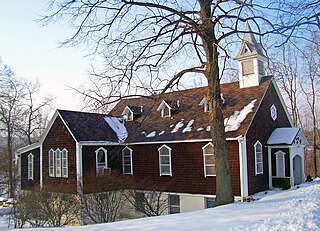
Chapel Hill Bible Church, formerly Amity Baptist Church, is a Baptist house of worship located off Bingham Road near Marlboro, New York, United States. It is a small wooden building in the Picturesque mode of the Gothic Revival architectural style dating to the mid-19th century. In 2005 it was listed on the National Register of Historic Places. It is the southernmost property on the Register in Ulster County.

Elizabeth Catherine Ferard was a deaconess credited with revitalising the deaconess order in the Anglican Communion. She is now remembered in the Calendar of saints in some parts of the Anglican Communion on either 3 or 18 July.

Rutherford Waddell (1850–1932) was a notable New Zealand Presbyterian minister, social reformer and writer. He was born in Ireland and after failing to finding a position as a missionary or a minister Waddell and his wife migrated to New Zealand in 1877. Settling in Dunedin he led St Andrew's Presbyterian Church for forty years from 1879 to 1919. An important liberalizing influence in the Presbyterian church in New Zealand he was an active believer in the value of the ministry to promote social justice. This led him to oversee the setting up a mission hall, savings bank, free library and free kindergarten within his parish, as well as promoting the founding of a variety of cultural and sporting groups.
Chicago Training School for Home and Foreign Missions was a training school in Chicago for missionaries associated with the Methodist Church. It was founded by Lucy Rider Meyer and her husband Josiah in 1885 and was described as "the largest training school of its kind in the country" and awarded the degree of Bachelor of Religious Service (BRS).

Lucy Webb Hayes National Training School was a religious training school, now a hospital, in Washington, D.C. So named in memory of Lucy Webb Hayes, the wife of former President Rutherford B. Hayes. It was founded in 1891 and was the authorized training school of the Woman's Foreign Missionary Society of the Methodist Episcopal Church, which owned the property of the school, exercised supervision and jurisdiction over its management, and looked to it to supply the trained workers employed by the society in its widely diversified fields of labor. The privileges of the school were not, however, confined to those connected with the Woman's Home Missionary Society. It opened its doors to all who wanted to prepare themselves for any department of Christian activity. In 1894, the school was chartered by act of Congress in conjunction with the Deaconess Home and Sibley Memorial Hospital, and formed with them one corporation. The unified administration and guaranteed the training of Christian workers.
African-American socialism is a political current that emerged in the nineteenth century, specifically referring to the origins and proliferation of Marxist ideologies among African-Americans for whom socialism represents a potential for equal class status, humane treatment as laborers, and a means of dismantling American capitalism. Black liberation is in line with Marxist theory, which asserts that the working class, regardless of race, has a common interest against the bourgeoisie.
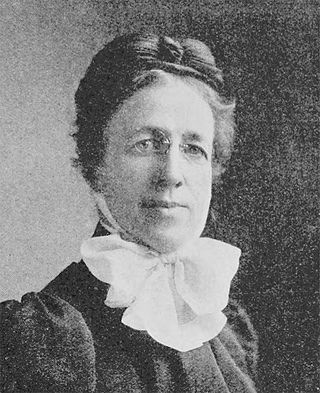
Lucy Jane Rider Meyer was an American social worker, educator, physician, and author who cofounded the Chicago Training School for City, Home, and Foreign Missions in Illinois. She is credited with reviving the office of the female deacon in the U.S. Methodist Episcopal Church.


Jane Marie Bancroft Robinson was an author and educator.
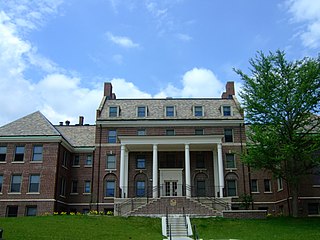
The Methodist Deaconess Institute—Esther Hall, also known as Hawthorn Hill Apartments, is a historic building located in Des Moines, Iowa, United States. This building has been known by a variety of titles. They include the Bible Training School, Women's Foreign Missionary Society; Women's Home Missionary Society-Bible Training School; Iowa National Bible Training School; Iowa National Esther Hall & Bidwell Deaconess Home; Hawthorn Hill; and Chestnut Hill. The Women's Home Missionary Society of the Methodist Episcopal Church established a Des Moines affiliate in 1896. Part of their responsibilities was to oversee the work of deaconesses of the church. At about the same time a Bible training school was established at Iowa Methodist Hospital's School of Nursing.

Frances Stern (1873–1947) was one of the first nutritionists in the United States. In 1918 she founded the Boston Dispensary Food Clinic, which evolved into what is now the Frances Stern Nutrition Center at Tufts Medical Center.

Goodrich Social Settlement was the second settlement house in Cleveland, Ohio, after Hiram House. It organized on December 9, 1896, incorporated May 15, 1897, and opened May 20, 1897 at Bond St. and St. Clair Ave. It was established by Flora Stone Mather as an outgrowth of a boys' club and women's guild conducted by the First Presbyterian Church. Its aims were “to provide a center for such activities as are commonly associated with Christian social settlement work". It was maintained by an endowment. The Goodrich House Farm, in Euclid Point, Ohio, was part of the settlement.
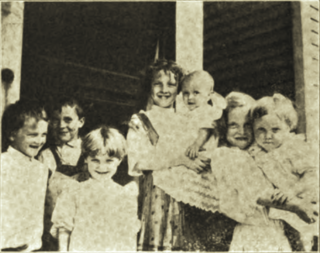
Neighborhood House was an American settlement house in Chicago, Illinois. It was opened in October 1896, by Samuel S. and Harriet M. Van Der Vaart, under the auspices of the Young People's Society of the Universalist Church, of Englewood, Chicago, and with the assistance of teachers of the Perkins, Bass, and D. S. Wentworth public schools. It was officially established in the Fall of 1897 by Harriet Van Der Vaart as the outgrowth of the kindergarten opened the year before "to bring together for mutual benefit people of different classes and conditions."
Whittier House was an American social settlement, situated in the midst of the densely populated Paulus Hook district of Jersey City, New Jersey. Christian, but non-denominational, its aims were to help all in need by improving their circumstances, by inspiring them with new motives and higher ideals, and by making them better fitted by the responsibilities and privileges of life. It cooperated with all who were seeking to ameliorate the human condition and improve the social order. It opened in the People's Palace, December 20, 1893. On May 14, 1894, it incorporated and moved to 174 Grand Street.
References
- ↑ Directory of Social Agencies of the City of New York. Columbia University Press. 1899. Retrieved 3 November 2022.
 This article incorporates text from this source, which is in the public domain .
This article incorporates text from this source, which is in the public domain . - 1 2 3 4 5 6 7 8 9 10 11 12 New York (State) Bureau of Labor Statistics (1901). Annual Report of the Bureau of Labor Statistics of the State of New York for the Year ... James B. Lyon, State Printer. pp. 365–68. Retrieved 3 November 2022.
 This article incorporates text from this source, which is in the public domain .
This article incorporates text from this source, which is in the public domain . - ↑ Bibliography of College, Social, University and Church Settlements. Blakely Press. 1905. pp. 68–69. Retrieved 4 November 2022.
 This article incorporates text from this source, which is in the public domain .
This article incorporates text from this source, which is in the public domain . - 1 2 3 Woods, Robert Archey; Kennedy, Albert Joseph (1911). "NEW YORK CITY NEIGHBORHOOD HOUSES MAINTAINING RELIGIOUS INSTRUCTION". Handbook of Settlements. Charities Publication Committee. pp. 233–35.
 This article incorporates text from this source, which is in the public domain .
This article incorporates text from this source, which is in the public domain .